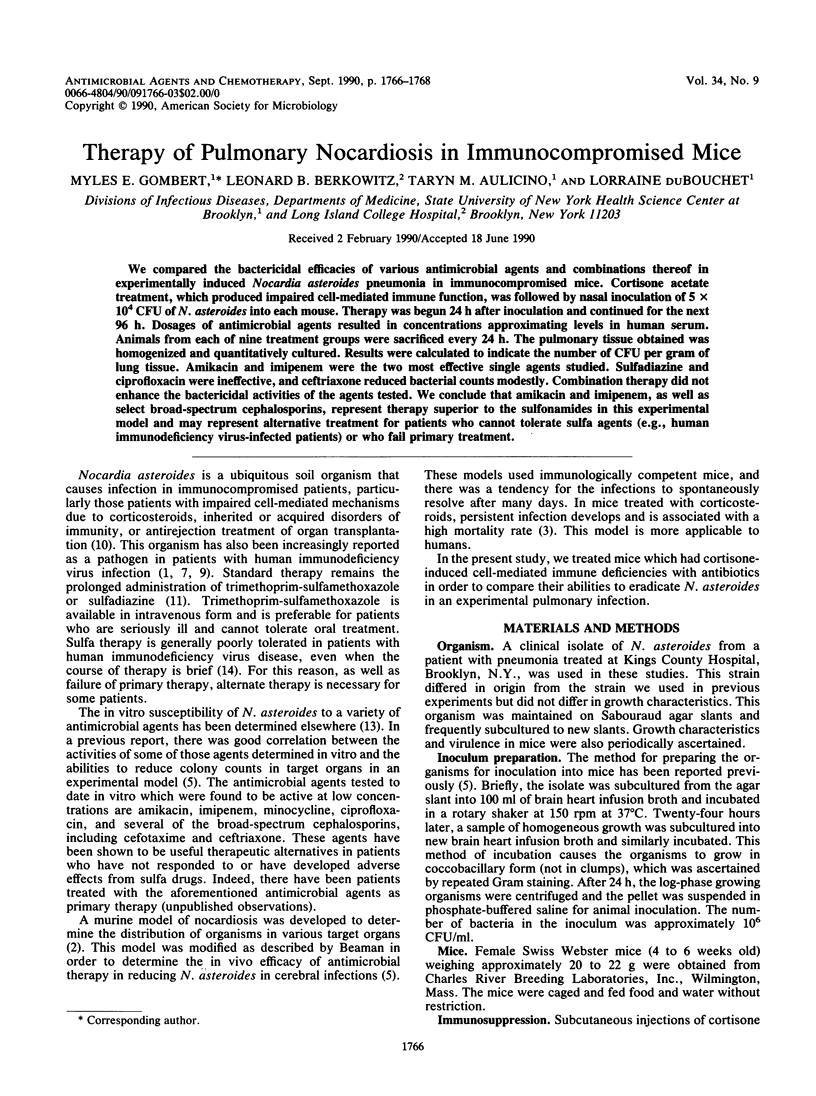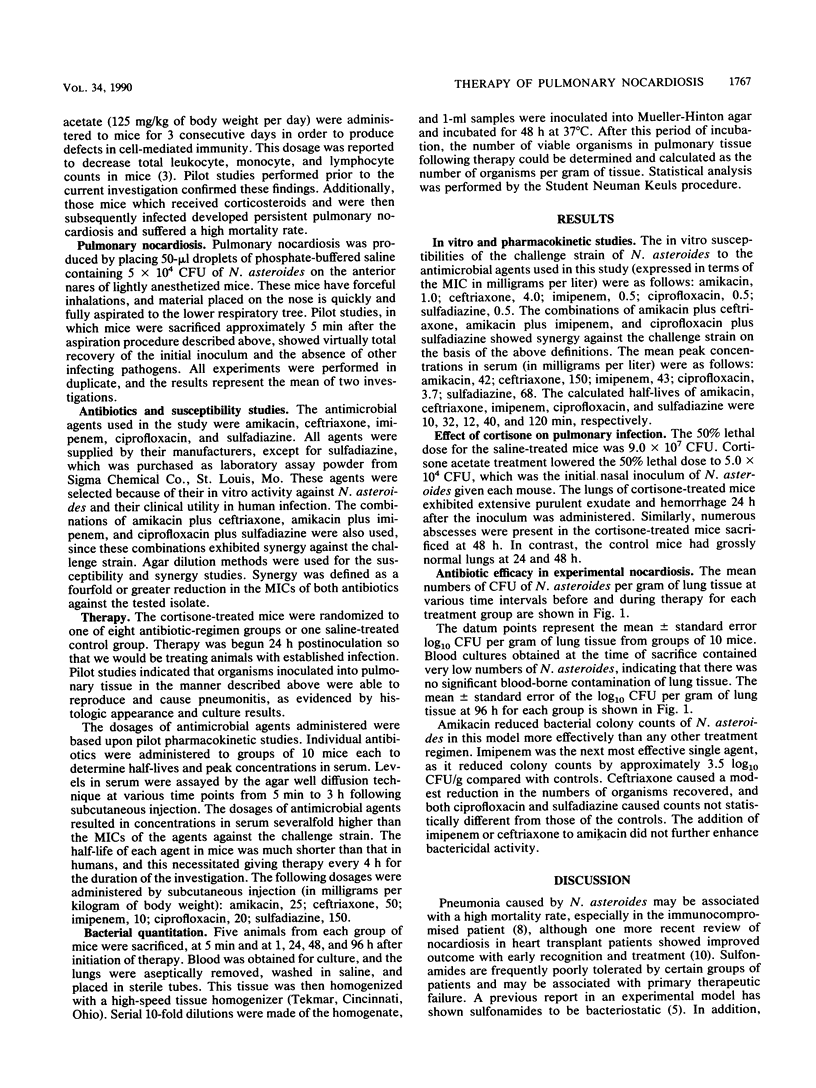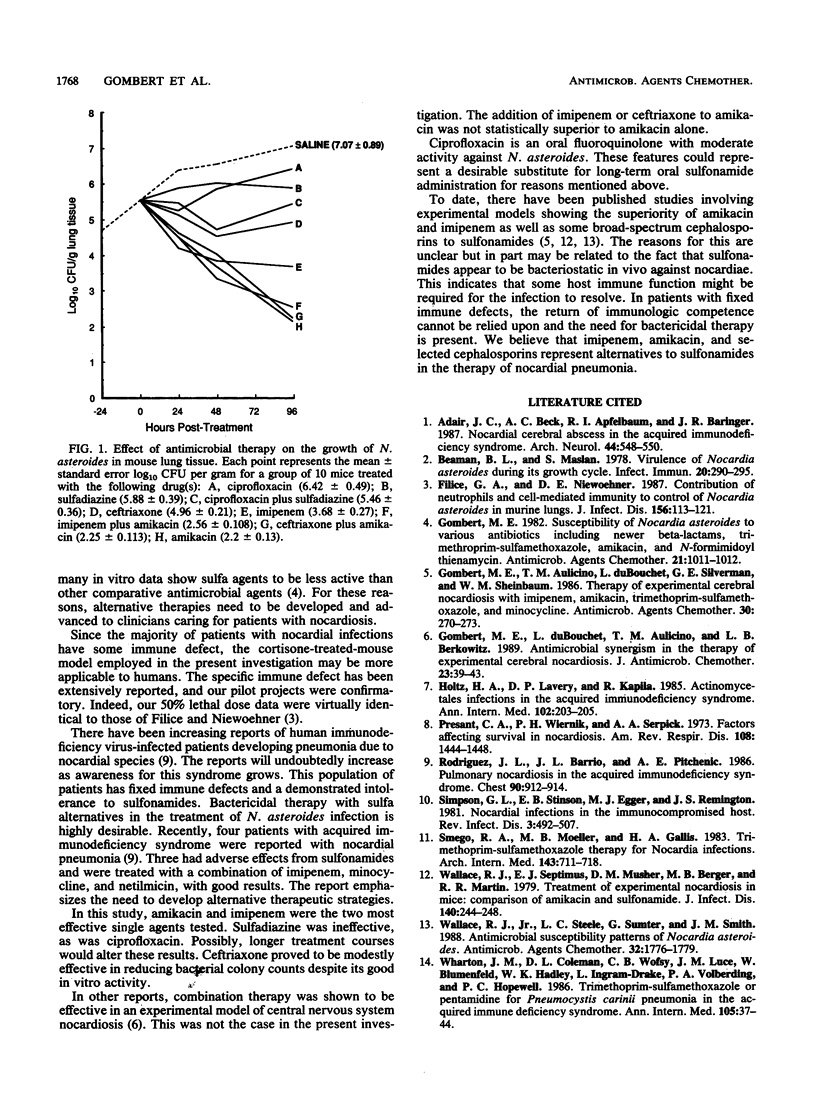Abstract
We compared the bactericidal efficacies of various antimicrobial agents and combinations thereof in experimentally induced Nocardia asteroides pneumonia in immunocompromised mice. Cortisone acetate treatment, which produced impaired cell-mediated immune function, was followed by nasal inoculation of 5 x 10(4) CFU of N. asteroides into each mouse. Therapy was begun 24 h after inoculation and continued for the next 96 h. Dosages of antimicrobial agents resulted in concentrations approximating levels in human serum. Animals from each of nine treatment groups were sacrificed every 24 h. The pulmonary tissue obtained was homogenized and quantitatively cultured. Results were calculated to indicate the number of CFU per gram of lung tissue. Amikacin and imipenem were the two most effective single agents studied. Sulfadiazine and ciprofloxacin were ineffective, and ceftriaxone reduced bacterial counts modestly. Combination therapy did not enhance the bactericidal activities of the agents tested. We conclude that amikacin and imipenem, as well as select broad-spectrum cephalosporins, represent therapy superior to the sulfonamides in this experimental model and may represent alternative treatment for patients who cannot tolerate sulfa agents (e.g., human immunodeficiency virus-infected patients) or who fail primary treatment.
Full text
PDF


Selected References
These references are in PubMed. This may not be the complete list of references from this article.
- Adair J. C., Beck A. C., Apfelbaum R. I., Baringer J. R. Nocardial cerebral abscess in the acquired immunodeficiency syndrome. Arch Neurol. 1987 May;44(5):548–550. doi: 10.1001/archneur.1987.00520170074026. [DOI] [PubMed] [Google Scholar]
- Beaman B. L., Maslan S. Virulence of Nocardia asteroides during its growth cycle. Infect Immun. 1978 Apr;20(1):290–295. doi: 10.1128/iai.20.1.290-295.1978. [DOI] [PMC free article] [PubMed] [Google Scholar]
- Filice G. A., Niewoehner D. E. Contribution of neutrophils and cell-mediated immunity to control of Nocardia asteroides in murine lungs. J Infect Dis. 1987 Jul;156(1):113–121. doi: 10.1093/infdis/156.1.113. [DOI] [PubMed] [Google Scholar]
- Gombert M. E., Aulicino T. M., duBouchet L., Silverman G. E., Sheinbaum W. M. Therapy of experimental cerebral nocardiosis with imipenem, amikacin, trimethoprim-sulfamethoxazole, and minocycline. Antimicrob Agents Chemother. 1986 Aug;30(2):270–273. doi: 10.1128/aac.30.2.270. [DOI] [PMC free article] [PubMed] [Google Scholar]
- Gombert M. E. Susceptibility of Nocardia asteroides to various antibiotics, including newer beta-lactams, trimethoprim-sulfamethoxazole, amikacin, and N-formimidoyl thienamycin. Antimicrob Agents Chemother. 1982 Jun;21(6):1011–1012. doi: 10.1128/aac.21.6.1011. [DOI] [PMC free article] [PubMed] [Google Scholar]
- Holtz H. A., Lavery D. P., Kapila R. Actinomycetales infection in the acquired immunodeficiency syndrome. Ann Intern Med. 1985 Feb;102(2):203–205. doi: 10.7326/0003-4819-102-2-203. [DOI] [PubMed] [Google Scholar]
- Presant C. A., Wiernik P. H., Serpick A. A. Factors affecting survival in nocardiosis. Am Rev Respir Dis. 1973 Dec;108(6):1444–1448. doi: 10.1164/arrd.1973.108.6.1444. [DOI] [PubMed] [Google Scholar]
- Rodriguez J. L., Barrio J. L., Pitchenik A. E. Pulmonary nocardiosis in the acquired immunodeficiency syndrome. Diagnosis with bronchoalveolar lavage and treatment with non-sulphur containing drugs. Chest. 1986 Dec;90(6):912–914. doi: 10.1378/chest.90.6.912. [DOI] [PubMed] [Google Scholar]
- Simpson G. L., Stinson E. B., Egger M. J., Remington J. S. Nocardial infections in the immunocompromised host: A detailed study in a defined population. Rev Infect Dis. 1981 May-Jun;3(3):492–507. doi: 10.1093/clinids/3.3.492. [DOI] [PubMed] [Google Scholar]
- Smego R. A., Jr, Moeller M. B., Gallis H. A. Trimethoprim-sulfamethoxazole therapy for Nocardia infections. Arch Intern Med. 1983 Apr;143(4):711–718. [PubMed] [Google Scholar]
- Wallace R. J., Jr, Septimus E. J., Musher D. M., Berger M. B., Martin R. R. Treatment of experimental nocardiosis in mice: comparison of amikacin and sulfonamide. J Infect Dis. 1979 Aug;140(2):244–248. doi: 10.1093/infdis/140.2.244. [DOI] [PubMed] [Google Scholar]
- Wallace R. J., Jr, Steele L. C., Sumter G., Smith J. M. Antimicrobial susceptibility patterns of Nocardia asteroides. Antimicrob Agents Chemother. 1988 Dec;32(12):1776–1779. doi: 10.1128/aac.32.12.1776. [DOI] [PMC free article] [PubMed] [Google Scholar]
- Wharton J. M., Coleman D. L., Wofsy C. B., Luce J. M., Blumenfeld W., Hadley W. K., Ingram-Drake L., Volberding P. A., Hopewell P. C. Trimethoprim-sulfamethoxazole or pentamidine for Pneumocystis carinii pneumonia in the acquired immunodeficiency syndrome. A prospective randomized trial. Ann Intern Med. 1986 Jul;105(1):37–44. doi: 10.7326/0003-4819-105-1-37. [DOI] [PubMed] [Google Scholar]


